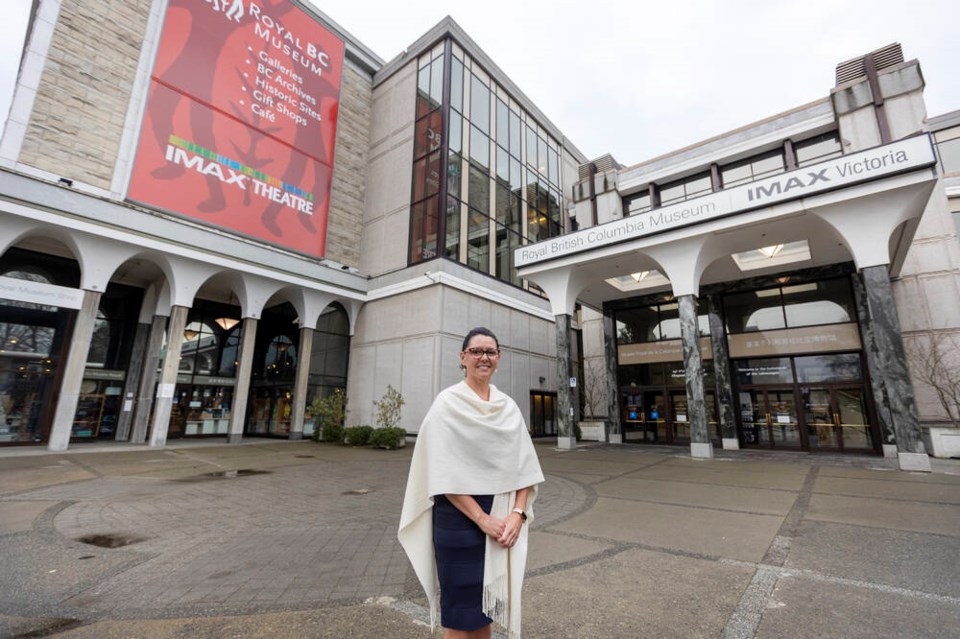The third floor of the Royal B.C. Museum remains largely intact a year after it was closed to “decolonize” the province’s human history exhibits.
While some smaller items have been removed and stored — and some repatriated to First Nations — Old Town, the Discovery ship and the First Peoples Gallery remain in place, waiting for their stories to be told in a more inclusive way, museum chief executive Alicia Dubois said in an interview on Friday.
Dubois, a lawyer who was hired last year as the museum was under intense criticism for ripping out its most popular exhibits, launched the first public dialogue session this week, seeking feedback on how the provincial museum should be redesigned.
That consultation comes after a tumultuous year when the top-floor galleries, which represent a third of the museum’s space, were closed, and plans for a $789-million replacement building were announced with fanfare — then scuttled a few months later by then-Premier John Horgan after a massive public pushback.
The museum is also preparing for two major new exhibits — one of which will crack open at least a portion of the third floor this spring.
SUE the T. Rex, the largest Tyrannosaurus rex ever discovered, will open in June, taking over a 5,000-square-foot area formerly occupied by the Living Languages exhibit (now a travelling show) and Century Hall. Space for the 40-foot-long, 13-foot-tall T. Rex, unearthed in North Dakota in 1990 and loaned by the Field Museum, was being prepared this week.
The Royal B.C. Museum is also announcing this month its first major travelling exhibit since before the pandemic — Treasures of Cambodia’s Angkor Wat, which is expected to draw crowds not seen since Leonardo da Vinci and Genghis Khan exhibits. Paired with an IMAX movie, it will run from June to the end of December.
Dubois said the sessions to collect feedback from the public and First Nations communities are being offered through spring as in-person and online events. Surveys will also be made available before deeper consultations involving First Nations, municipalities, post-secondary institutions, other museums and businesses.
The First Peoples Gallery is being modified as a meeting space for consultations with First Nations. At least one totem is being returned to an undisclosed First Nation in coming weeks, while another two viewable from behind glass outside the museum were repatriated in October, said Dubois.
Future dialogue sessions will also include public visits to exhibits on the third floor, Dubois said.
“We’re genuine about wanting to ensure that we get this right,” said Dubois. “This is the people’s museum. Community as authority. Period.”
Dubois said remaking the museum will take time. “Museums around the world have three-year exhibition plans and five-year exhibition plans … you just can’t hang things up. You have to listen and plan.”
Dubois was asked by some at the initial dialogue session why displays like Old Town could not remain open while the stories associated with them evolve.
While Old Town is not coming back in the same form, Dubois said, “the bones” of it remain and it will be opened up as the engagement process continues. “The Chinese community has told us they do not want us to dismantle their space. They want it to stay and we will honour that. But we need more of that. We need more diversity in Old Town.”
Dubois was blunt with one speaker who said the museum wasn’t listening to pleas to keep Old Town.
“I said you need to understand that not everybody feels that way,” said Dubois, adding the museum has to take the time to listen to other voices that may be reluctant to speak out because of past experiences.
“The challenge for [the museum] is that we are a Crown agency and we feel like the government. We’ve just gone through a period of being politicized and so for us, we need to build our own relationships and we’re here to change the museum, here to be a facilitator of storytelling instead of the authority.”
The settler displays of the farm, logging and mining as well as the Indigenous pit house will not be redesigned because they were built with materials containing asbestos.
Those areas are being used to store artifacts and other items that will likely be headed to the museum’s new Collections and Archives Building at Royal Bay in Colwood, scheduled to open in mid-2025.
Old Town is also full of asbestos, but it’s behind the walls, Dubois said. “So if we can repurpose Old Town to be much more inclusive and diverse in the history of the province then that’s the right way to go, because we don’t have to go through massive hazmat and require a shutdown.”
Captain George Vancouver's model ship, Discovery, is likely to remain part of the third-floor gallery, but could be presented to reflect the arrival of colonialism and, for some, the darker sides of the province’s history.
“The ship Discovery is all about settlers as a hero’s story,” said Dubois.
She said discussions with First Nations revealed there was another Royal Navy ship, HMS Destruction, that travelled the B.C. coast bombing communities in order to gain First Nations compliance. An archivist at the museum found records of the ship in the federal government’s naval records with ship’s logs documenting the bombings.
Dubois realizes there are aspects of the province’s history that some people won’t like to hear
“There are important stories, and it’s not to take away [from Cook], but it’s just to ensure we all really understand our space together and the history we have.”
The Pocket Gallery on the ground floor and an online portal will used to provide live updates on the engagement process.



